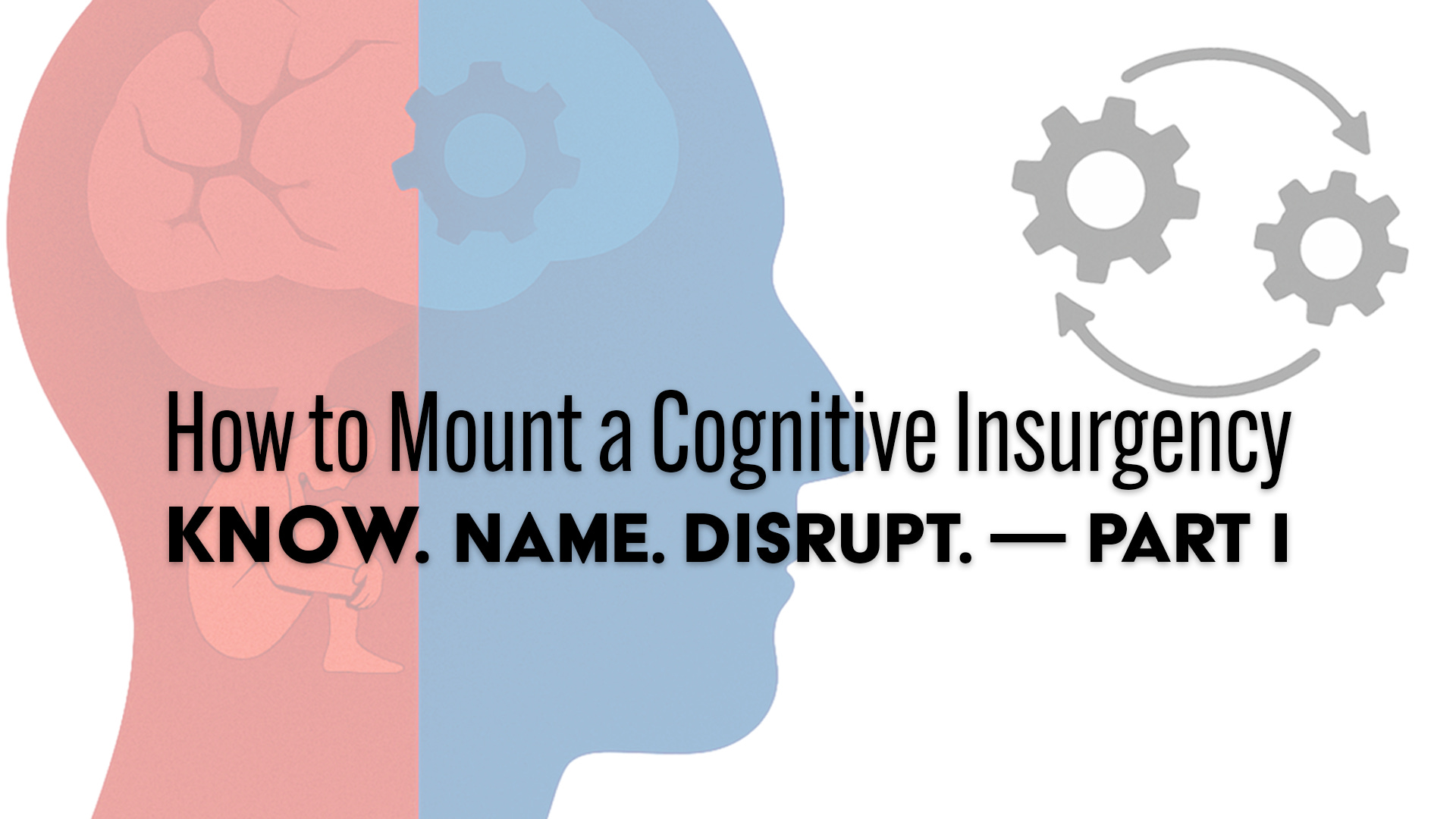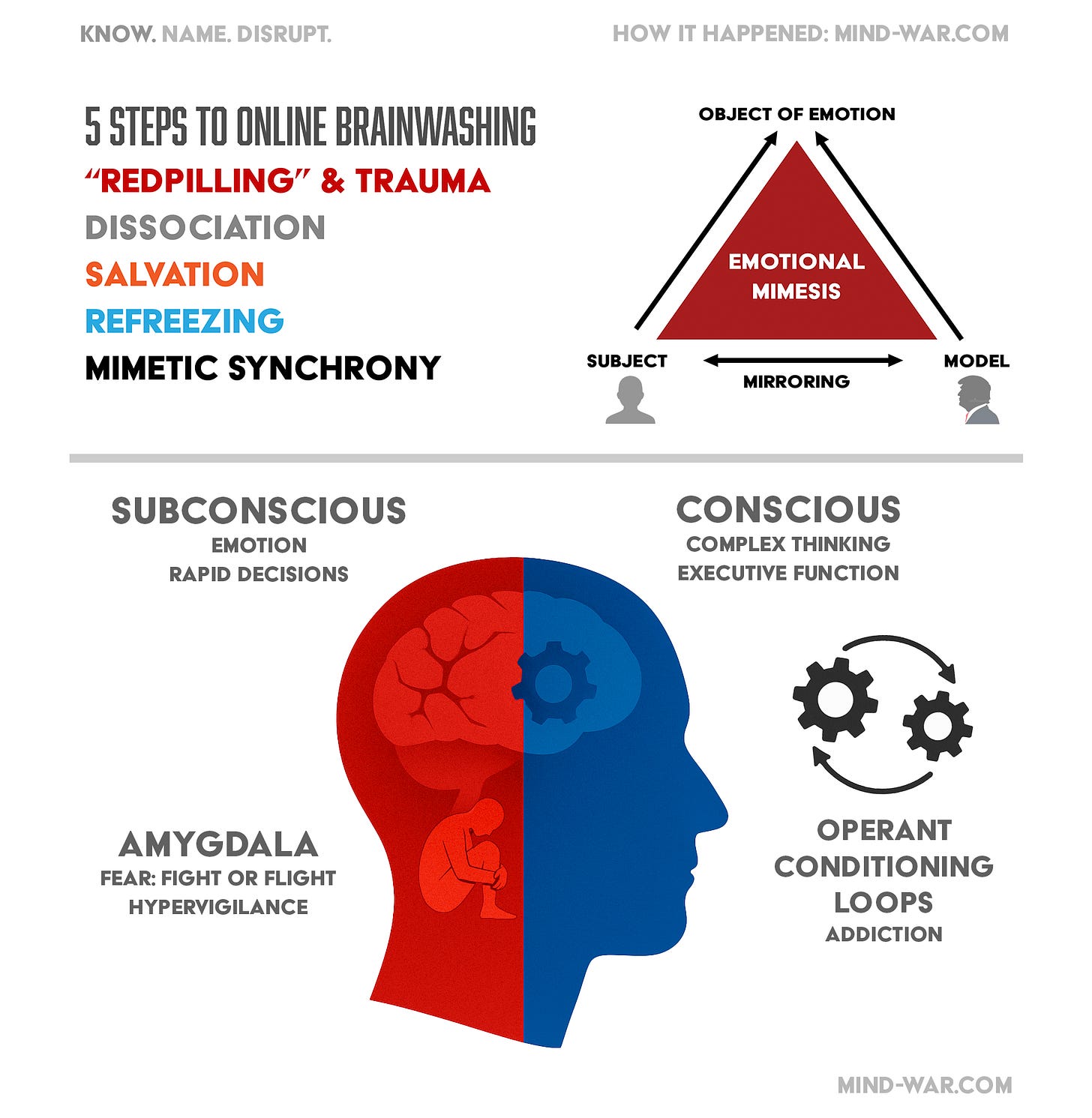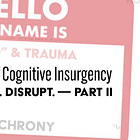How to Mount a Cognitive Insurgency: KNOW. Name. Disrupt. — Part I
In a regime of epistemological totalitarianism, just KNOWING is resistance.
Recently I published a theoretical framework for how Donald Trump has gained such a psychological grip on a large minority of the U.S. population, as well as the behavior of the government under his regime.
The next sensible question is: What do we do about it? How do we mount a true resistance to such a complex, self-reinforcing, and voracious machine?
I propose a simple but radical framework for everyone who wants to do their part to break the psychological lock on so many of our family, friends, and neighbors—and to bit by bit, person by person, dismantle the machine that emotionally enslaved them:
Know. Name. Disrupt.
In this article, I will focus on the first part of the framework: Know.
All authoritarian regimes involve information control because a free-thinking population is hard to dominate. To avoid this, they make sure the population has limited, or false, information.
“Destructive mind control can be understood in terms of four basic components: Behavior Control, Information Control, Thought Control, and Emotional Control.”
Dr. Steven Hassan, Combating Cult Mind Control
In the current regime led by Donald Trump, this has been taken to an extreme—in just the first six months of his second term.
Press, lawyers, universities, students, and statisticians who don’t bend to the will of the federal government are being publicly persecuted. Trump uses numbers as a weapon and a loyalty test. On the same day he fired the head of the Bureau of Labor Statistics for producing numbers he didn’t like, he used an innumerate claim about drug prices. His sycophants went right along:
Here is a quote from Orwell’s 1984, for comparison:
“In the end the Party would announce that two and two made five, and you would have to believe it.”
―George Orwell,1984
But why? What makes Brilyn Hollyhand effectively a mirror of Donald Trump, math be damned? Knowing the answer is powerful. Here’s why:
It is an inoculation. It is well-documented that understanding the tactics of psychological manipulation makes you less susceptible to them.
It prevents spread of the cognitive contagion to the people around you and provides you the information you need to make better decisions and, where possible, to take action.
Mimesis
For me personally, I know some of my longest-lasting memories are the moments when one of my kids, as a baby, smiled back at me, or his mom, for the first time. It’s not just a baby anymore at the moment, it’s awake. It really sees you. Mimicry or mimesis is a fundamental part of human learning, growth, and connection.
Here’s another moment most people can identify with: You have a crush on someone, and you see them walking towards you down the hall. You gather up the courage to smile, and they smile back. It’s an emotionally charged moment, right?
Let’s break down this old cliché:
Imitation is the sincerest form of flattery.
Why is it the most sincere form of flattery? Because it’s mostly subconscious. When the baby or the unrequited love in the hallway smiles back, it’s—generally—an unconscious decision.
However, the negative implications of emotional mimesis are just as powerful. As an example: a victim of domestic abuse will often mirror their abuser in real-time. If the victim is home when their abuser returns from work they may instantly change their mood to match the perpetrator’s expressions as a defense mechanism—to avoid a verbal or physical assault. This is, in effect, emotional enslavement. The system of rewards and punishments is neurologically addictive.
If you think about that kind of trauma bond writ large, that is the level of mimetic, emotional control that Donald Trump has on many of his followers.
Here is a first draft of what I believe people need to know in order to avoid this kind of psychological trap, in simple diagram form.
I asked an AI to explain the diagram above to a bright 10-year-old:
Imagine your brain is like a machine with two sides.
One side is your feelings—like fear, love, anger. It works really fast, almost like a superhero who reacts before you even think.
The other side is your thinking brain—the part that helps you plan, make decisions, and know right from wrong. It’s slower, but it’s really smart.
Now, imagine someone wants to trick both sides of your brain at the same time.
🎭 Step 1: Scare you
First, they show you something scary or confusing—like a creepy video or a big lie. That gets your fast brain (your feelings) all worked up.
🧊 Step 2: Overload you
Next, your brain gets overwhelmed, like a computer that crashes. You feel lost or unsure who to trust.
🛟 Step 3: Save you (but it’s fake)
Then, the person who scared you says, “Only I can help you.”
So now, you feel like you need them—even if they’re the ones who made you scared in the first place.
🔁 Step 4: Make you repeat
They keep giving you messages again and again so you start repeating them too. And if you try to say something different, they get mad.
🧲 Step 5: Sync you up
Now, you start copying their emotions without even knowing it—just like how a baby copies a smile.
That’s called mimesis. It means your feelings match theirs, even if it’s anger, hate, or fear.
Meanwhile, they also try to get your thinking brain addicted—by giving you little rewards or likes or special praise just for saying what they want you to say.
So now both your fast brain and smart brain are being tricked.
But here’s the cool part:
If you know this is what they’re doing, it’s like having a flashlight in a dark room.
You can say, “Wait! I see the trap!”
And when you see it, you can step around it—before it catches you.
The basic concepts of how this works are both scientifically well-understood and a natural part of human experience. It’s not actually that complicated to explain, but if you don’t know the tricks, anyone can fall for it.
The phrase variable-ratio infinite operant conditioning loop is a long way of saying a system of reward and punishment that never ends and is unpredictable. This is the essence of social media feeds like Twitter and Facebook. Doomscrolling for the occasional nugget of joy is the addiction that many of us suffer.
However, in the case of followers of Donald Trump, this is paired with another addiction loop, which is deeper and more primal; he has through a system of trauma and rewards, gotten tens of millions of people to mirror him, personally.
To do this requires execution and control of everything in the diagram above. He has control of the entire operating system of his victims. He controls the subconscious through trauma, he controls the conscious mind with operant conditioning. He controls behavior with emotional mimesis.
A massive, never-ending pipeline of traumatic content and willing participants in the “redpilling” of others is what makes it possible to execute all five steps of the brainwashing process. But if you know that traumatic content is the cause of psychological harm and entrapment, you will both make different choices about what you expose yourself to, and experience the content differently if you do. By forcing your conscious mind to constantly name and analyze what you’re seeing, the content’s power to harm your subconscious is drastically lowered.
This is why knowing matters. It’s not just a protective shield for yourself, it’s a firewall against spread. If enough people can just understand what’s happening to them, we can, in the first instance, stop the contagion.
If you know that the redpill is a trauma delivery mechanism designed to brainwash you, you will be far less likely to watch it. If you know the meme is a baited hook, you will be less likely to spread it. If you know how the system works together, you will see the “influencer” as just another mirror, a proxy for the leader’s emotions. And if you know that social media feeds are variable-ratio infinite operant conditioning loops designed to change your mind, your emotions, and your behavior, you will be less likely to doomscroll incessantly.
Knowing, of course, is just the first part, but it is critical. It’s like they tell you on the airplane in an emergency: Put your oxygen mask on first, so you can help the people around you.
Next: Part II — Why naming it, both inside and outside, is vital.
If you are able to help me continue my work, please consider upgrading to a paid subscription. It really means a lot. Thank you!
Here are a few benefits to upgrading:
Live Zoom call each Sunday
Substack Live AMA every week, video posted for paid subscribers
Ability to comment and access all content
Wonderful, supportive community
Helping independent journalism fill in the gaps for our failing media
Thank you for reading and sharing my work. Grateful for your support.
If you’d like to help me with expenses, here is my DonorBox. 💙
If you’d like to help with my legal fees: stopmikeflynn.com.
My podcast is @radicalizedpod & YouTube — Livestream is Thursdays at 4PM PT.
Bluesky 🦋: jim-stewartson
Threads: jimstewartson
Tiktok: @jimstewartson








Brilliant essay Jim, you've got to get back on the Thom Hartmann program ASAP. That said, what has frustrated and fascinated me for years,is the Fox channels absolute hold on it's viewers?!! Another head punch for sure. Thanks, Jim, can't wait for round two, and will reStack ASAP 💯👍
How different is this from Scientology?